The Museum Collections
Introduction
I. History and Art Collection
1. Icons of the 14th – 19th centuries
icons of the 14th – 17th century
2. Jewelry art of the 14th – 20th century
jewelry art of the 14th – 17th century
jewelry art of the 18th – 19th century
the european silver 14th - 19th centuries
3. Small-size sculptures (works of metal, wood, bone)
XI – the beginning of the XX century
Small-size sculptures 11th – 17th century
Small-size sculptures 18th – early 20th century
enamel of Troitza masters 15-8th – early 20th century
5.Embroidery, lace, textiles of the 14th - early 20th century
icon and ornamental embroidery
gold and silver lace
6.Painting of the 18th – 21st centuries
painting of the 18th – 19th centuris
painting of the 20th – 21st centuris
II.Manuscripts and old printed books of the 14th – 17th century
IV.Lithography of the 18th – 19th century
V.Numismatics
VI.Medals of the 18th - early 20th century
VIII.Archeology collection
IX. Russian folk and applied and decorative art of the 17th – 21st c.
1. Artistic wood
folk carved and painted wood
wooden toys
house carving of Sergiev Posad
Khokhloma and Gorodets painting
2. Artistic textiles
embroidery and weaving
printed textiles and lace
Russian shawls
folk costumes
folk garments
printed cotton kerchiefs
|
Painting of the 18th – 19th century (p.2) |
Portraits of members of imperial family continue so to appear in the Trinity-St. Sergius Lavra in the 19th century. Quite often, they are professionally executed copies of Russian artists from originals of foreign painters. Among them, it is possible to note two small portraits with images of emperors: Alexander I (Ill. 13) in style of the French painter Gerard, and Nicolay I, in style of German artist Kruger.
In the beginning of the 19th century has painted the double portrait of Emperor Alexander I with Empress Elizabeth Alekseevna, that allegorically reflecting event of war 1812. This picture carries the conditional name "World of Europe" (Ill. 14). Possibly, these images were prompted by S. Cardelli’s and A.Afanasev's engravings –"Alexander I releases France and restores the peace in Europe" or "The Peace of Europe". The allegory has solved in the portrait form of a couple of Russian emperor and empress with olive branch in hands. Near to the image is the comments inscription.
On boundary of 18-19th centuries, the increasing value gets a chamber portrait. They quite often decorated interiors of manors of noble family and merchant houses. It is possible to carry two portraits to their number: the unknown person in a cap and a kerchief and the unknown person with St. Vladimir's award and St. Anna's cross, stylistic concerning to end the 18th century (Ill. 15,16).They have arrived in a museum, most likely, in an operating time of the commission on monastery protection, and their origin, probably, has connected with inspection of surrounding manors.
|
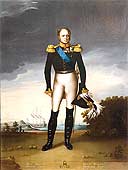
Ill. 13 |
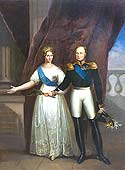
Ill. 14 |
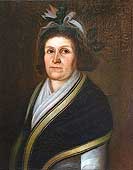
Ill. 15 |
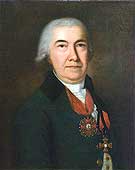
Ill. 16
|
The man's portrait, written in a little romantic spirit, belongs to the brush of Carl Lasch, popular German artist in Russia in the middle of the 19th century (Ill. 17).For a portrait are characteristic professionalism of the painting, reliability of the image, ability to like the customer that is peculiar Carl Lasch's to manner. Some portraits of the 19th century are connecting with names of little-known or unknown artists. Interesting work is the portrait of the unknown person in a white cap (Ill. 18). It is dated of 1830-s, when dresses with wide sleeves-gigot and air kerchiefs were fashionable. The portrait involves with harmony of a light image of the pretty woman and elegant coloristic decisions of all details of clothes.
TThe level of separate works allows carrying them to group so-called "the second culture", that is the raznochinetz’s city culture or rural environment. Nonprofessional painters, whose art answered tastes of growing merchants, usually carried out these portraits. In our collection images of the Sergievsky postmaster and his wife concern group of a city "household" or so-called "primitive" portrait portrait (Ill. 19,20).The name of portraits is conditionally and given because in a hand the man holds the letter.
|
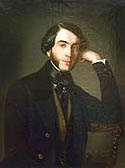
Ill. 17 |
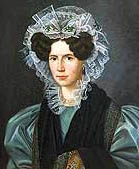
Ill. 18 |
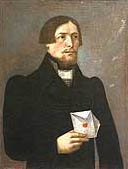
Ill. 19 |
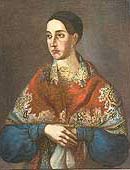
Ill. 20
|
The following group of pictures unites picturesque works, in which basis of plots are put historical events. The historical genre was the main thing in hierarchy of genres of Academy of Arts. In its best samples, artists have expressed ideals of time, having filled compositions the heroic, romantic and melodramatic maintenance. In museum collection two cloths illustrate history of the Trinity-St. Sergius monastery in the beginning of the 17-th century: the sketch to S.D.Miloradovich's picture (1852-1943) "Defense of the Trinity-St. Sergius monastery" 1894 (Ill. 21) and M.I.Scotti's picture (1814-1861) "Dionicius Zobninovsky hands over the patriotic deed » 1851 (Ill. 22)
The portrait "Nikolay I in Serapion tent of the Trinity-St. Sergius monastery» ), written by the Troitsk master, concerns to historical genre. It testifies about visiting of Monastery by the Emperor in 1834. The picture "Scales" or "The State of affairs in Europe», concerning the end of 18th century and belonging, possibly, to brush of known engraver G.I.Skorodumov (Ill. 24), is unusual on their theme. This work transfers a political situation in Europe after Russian-Turkish war in the symbolical form, and is the rare sample of political satire in painting.
|
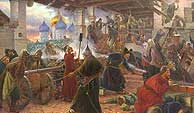
Ill. 21 |

Ill. 22 |

Ill. 23 |
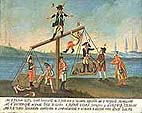
Ill. 24
|
|
About twenty works of art make group of the monuments, which basis of a plot is the Christian or secular allegory. The majority of them have executed, apparently, in the Trinity-St. Sergius monastery. The earliest work of art is the picture "Prayer of Gedeon" (Ill. 25), which is dated the middle 18th century and is connected with the order of the archimandrite of monastery Gedeon Krinovsky. The difficult allegory has put in the plot of the picture "Eulogy of affairs of Catherine II" (Ill. 26), created most likely at the very end of the 18th or the beginning of the 19th century. The allegory eulogizes not only state, educational, but also spiritual affairs of the Empress.
The picture «The Dream Borovikovsky» (Ill. 27),that belongs to a symbolist-religious theme, has written by V.L.Borovikovskiy in 1824, shortly before death. Last period of the artist made a note of the mystical religious moods, pouring out in forms of visions, which the artist aspired to define and designate by means of his art. The picture "The Phenomenon of the Mother of God to Saint Sergius of Radonezh", created in the middle of the 18th century in a picturesque masterful of the Trinity-St. Sergius monastery (Ill. 28).
|
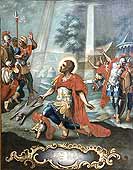
Ill. 25 |
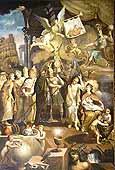
Ill. 26 |
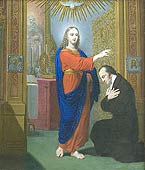
Ill. 27 |
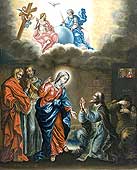
Ill. 28
|
|


